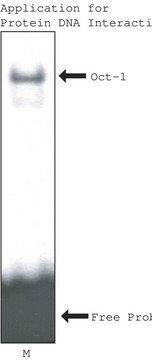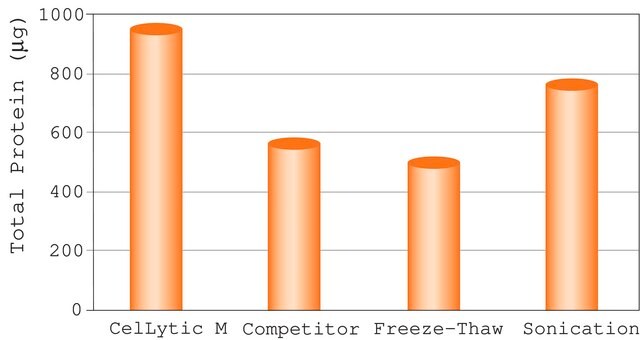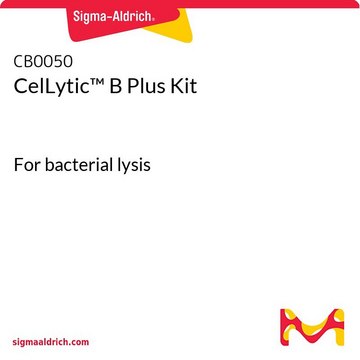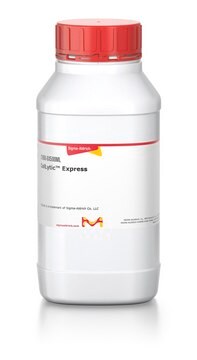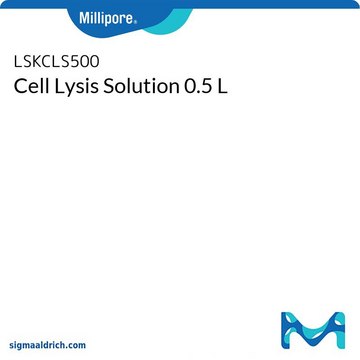B7435
CelLytic™ B Cell Lysis Reagent
For bacterial cell lysis, standard strength
Synonym(s):
Cell lysis reagent
Sign Into View Organizational & Contract Pricing
All Photos(1)
About This Item
Recommended Products
Quality Level
form
solution
Looking for similar products? Visit Product Comparison Guide
Application
CelLytic™ B Cell Lysis Reagent has been used for cell lysis for the extraction of coenzyme Q10, recombinant Src kinase associated phosphoprotein 1- glutathione S-transferases (GST) fusion protein and human α-synuclein.
A proprietary, non-denaturing formulation of zwitterionic detergents used for the lysis of bacterial cells and extraction of recombinant proteins.
Features and Benefits
- Higher protein extraction efficiency than traditional methods such as sonication and lysozyme
- Scalable for 1 to 25 grams of bacterial cell paste
- No interference with downstream applications such as affinity chromatography, IP, and Western blotting
- Compatible with protease inhibitors, inhibitor cocktails, chaotropes, salts, chelating agents and reducing agents
Other Notes
Detergent blend formulated in 40 mM Trizma® HCl (pH 8.0).
Legal Information
Covered by US Patent No 7,282,475 B2 and are sold for research use only. Commercial use requires addtional licenses.
CelLytic is a trademark of Sigma-Aldrich Co. LLC
Trizma is a registered trademark of Merck KGaA, Darmstadt, Germany
related product
Product No.
Description
Pricing
Signal Word
Warning
Hazard Statements
Precautionary Statements
Hazard Classifications
Eye Irrit. 2 - Skin Irrit. 2
Storage Class Code
12 - Non Combustible Liquids
WGK
WGK 3
Flash Point(F)
Not applicable
Flash Point(C)
Not applicable
Personal Protective Equipment
dust mask type N95 (US), Eyeshields, Gloves
Choose from one of the most recent versions:
Already Own This Product?
Find documentation for the products that you have recently purchased in the Document Library.
Customers Also Viewed
Ken Motohashi
BMC biotechnology, 15, 47-47 (2015-06-04)
Seamless ligation cloning extract (SLiCE) is a simple and efficient method for DNA assembly that uses cell extracts from the Escherichia coli PPY strain, which expresses the components of the λ prophage Red/ET recombination system. This method facilitates restriction endonuclease
Monika Raab et al.
Scientific reports, 9(1), 10462-10462 (2019-07-20)
While the immune cell adaptor protein SKAP1 mediates LFA-1 activation induced by antigen-receptor (TCR/CD3) ligation on T-cells, it is unclear whether the adaptor interacts with other mediators of T-cell function. In this context, the serine/threonine kinase, polo-like kinase (PLK1) regulates
Prion-like seeding of misfolded alpha-synuclein in the brains of dementia with Lewy body patients in RT-QUIC
Sano K, et al.
Molecular Neurobiology, 55(5), 3916-3930 (2018)
Kazunori Sano et al.
Acta neuropathologica communications, 9(1), 182-182 (2021-11-14)
Serine 129 (S129) phosphorylation of α-synuclein (αSyn) is a central feature of Lewy body (LB) disease pathology. Although the neighboring tyrosine residues Y125, Y133, and Y136 are also phosphorylation sites, little is known regarding potential roles of phosphorylation cross-talk between
Ca2+ increases the specific coenzyme Q10 content in Agrobacterium tumefaciens
Ha SJ, et al.
Bioprocess and Biosystems Engineering, 32(5), 697-700 (2009)
Our team of scientists has experience in all areas of research including Life Science, Material Science, Chemical Synthesis, Chromatography, Analytical and many others.
Contact Technical Service


